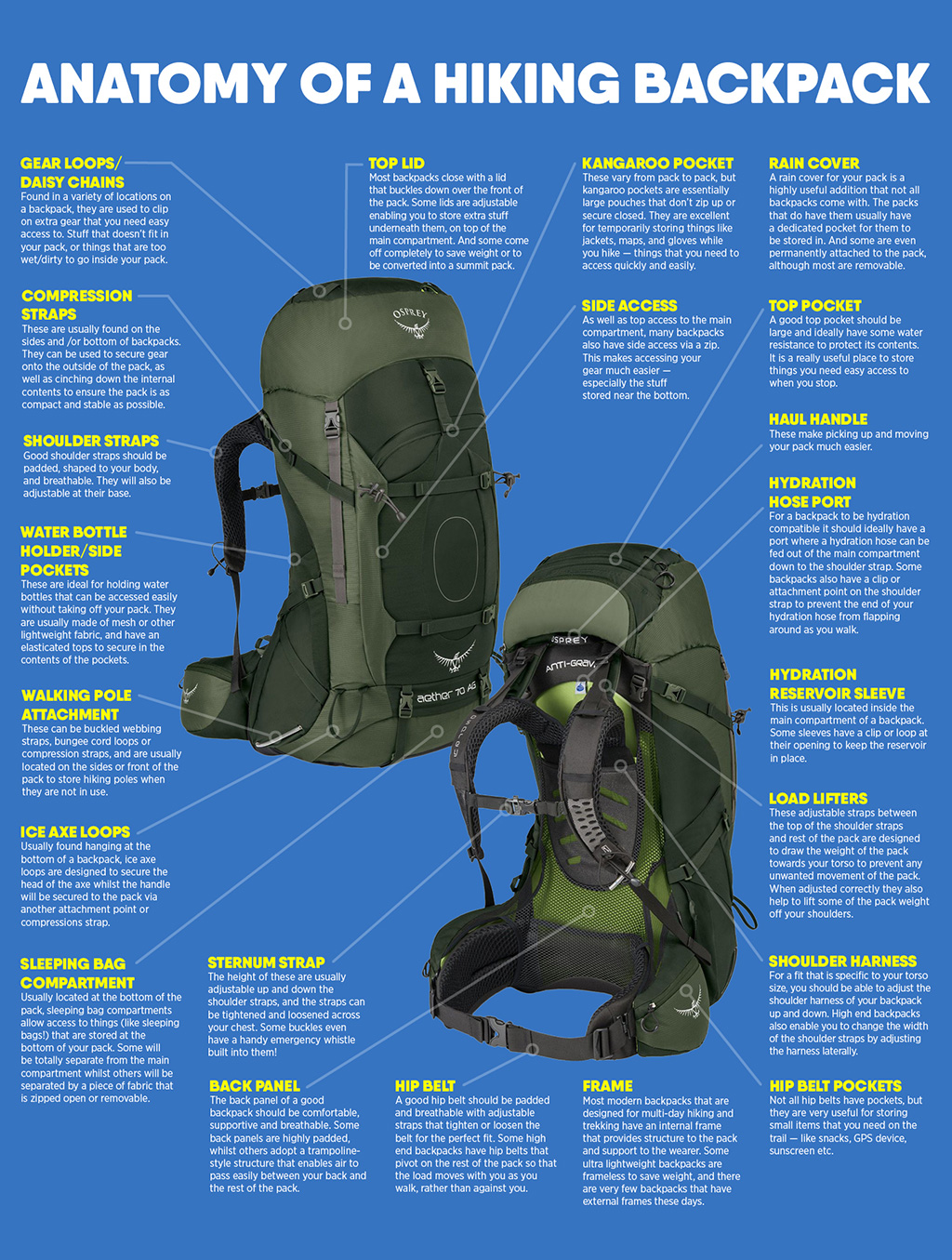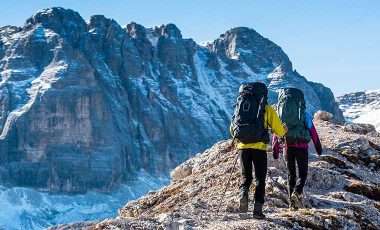Learn what all the different parts of a backpack are called, why they’re useful, and which are important for your backpacking needs.
A basic backpack needs little explaining. You fill it with stuff, close it with a buckle or zip, put your arms through the shoulder straps, and away you go!
Backpacks for backpacking, hiking and trekking, on the other hand, are much more complex. Not only are there many more components and parts of a backpack for hiking, but each part has a very specific and (mostly) necessary function. And with ever-evolving features that all claim to revolutionise your backpacking experience, it’s important to know and understand exactly what you’re buying.- The anatomy of a backpack
- Why it’s important to know the different parts of a backpack
- Parts of a backpack explained
The anatomy of a backpack
Once you’ve read the rest of this article you should have a better clearer picture of how you like to use your pack, and what sort of stuff you will and won’t be carrying in it. Then you can tackle the specifics with a touch more understanding of what to look for when buying a new backpack for your hiking and trekking adventures.

Share this image on your site
Why it’s important to know the different parts of a backpack
Understanding the anatomy of a backpack will seriously help when choosing a pack that is appropriate to your own hiking and backpacking needs and preferences. If you only intend hiking for short day hikes then many of the below features will be overkill. In that instance you’re better off heading straight to our hiking daypacks guide.
However, for multi day backpacking trips you’ll certainly need most of the structural parts of a backpack to be present to provide maximal support and comfort.
When it comes to overnight hiking backpacks you’ll find that many of the storage and usage features come down to personal preference. They depend upon how you like to organise your stuff in your pack and what stuff you will be carrying.
NOTE: If you’re not sure what type of backpack you need then be sure to check out our guide which explains all the different styles of backpacks, the desirable features of each and what they are best used for.
Before delving into the intricacies of the anatomy of backpacks for hiking, ask yourself the following questions:
- Do you drink from a hydration reservoir or a water bottle, or both?
- Do you hike with trekking poles or an ice axe?
- Do you like to snack on the move?
- Do you like to compartmentalise your gear or throw it all in together?
- Are you a minimalist, ultra lightweight hiker?
- Does the idea of multiple pockets make organisation even harder for you?
- Do you hate the idea of extra gear attached to the outside of your pack?
Ponder on those points while you check out the different parts of a backpack in more detail.
Parts of a backpack explained
Frame
Most modern backpacks that are designed for multi-day hiking and trekking have an internal frame that provides structure to the pack and support to the wearer. Some ultra lightweight backpacks are frameless to save weight, and there are very few backpacks that have external frames these days, although they are still being manufactured.
Load lifters
These adjustable straps between the top of the shoulder straps and rest of the pack are designed to draw the weight of the pack towards your torso. This helps to prevent any unwanted movement of the pack. When adjusted correctly they also help to lift some of the pack weight off your shoulders.
Sternum strap
The height of a sternum strap is usually adjustable up and down the shoulder straps, and the straps can be tightened and loosened across your chest. Some buckles even have a handy emergency whistle built into them!
Hip belt
A good hip belt should be padded and breathable with adjustable straps that tighten or loosen the belt for the perfect fit. Some high end backpacks have hip belts that pivot on the rest of the pack. This enables the load move with you as you walk, rather than against you.
Hip belt pockets
Not all hip belts have pockets, but they are very useful for storing small items that you need on the trail — like hiking snacks, GPS device, sunscreen etc.
Haul handle
Haul handles make picking up and moving your pack much easier.
Back panel
The back panel of a good backpacks should be comfortable, supportive and breathable. Some back panels are highly padded, whilst others adopt a trampoline-style structure. This enables air to pass easily between your back and the rest of the pack.
Shoulder straps
Good shoulder straps should be padded, shaped to your body, and breathable. They will also be adjustable at their base.
Shoulder harness
For a fit that is specific to your torso size, you should be able to adjust the shoulder harness of your backpack up and down. High end backpacks also enable you to change the width of the shoulder straps by adjusting the harness laterally.
Hydration hose port
For a backpack to be hydration compatible it should ideally have a port, or hole where a hydration hose can be fed out of the main compartment down to the shoulder strap.
Hydration hose clip
Some backpacks have a clip or attachment point on the shoulder strap to clip on your hydration hose. The purpose of this is to prevent the end of your the hose from flapping around as you walk.
Water bottle holder/side pockets
Side pockets are ideal for holding water bottles that can be accessed easily without taking off your pack. They are usually made of mesh or other lightweight fabric, and have elasticated tops to secure in the contents of the pockets.
Compression straps
Compression straps are usually found on the sides and /or bottom of backpacks. They can be used to secure gear onto the outside of the pack, as well as cinching down the internal contents to ensure the pack is as compact and stable as possible.
Gear loops/daisy chains
Gear loops can be found in a variety of locations on the outside of a backpack. They are used to clip on extra gear that you need easy access to. Things that don’t fit in your pack, or things that are too wet/dirty to go inside your pack.
Ice axe loops
Usually found hanging at the bottom of a backpack, ice axe loops are designed to secure the head of the axe whilst the handle will be secured to the pack via another attachment point or compressions strap.
Walking pole attachment
The ability to store your poles on your pack when you are not using them is key if you like to hike with trekking poles. The attachment points can be buckled webbing straps, bungee cord loops or compression straps, and are usually located on the sides or front of the pack.
Top pocket
A good top pocket should be large and ideally have some water resistance to protect its contents. It is a really useful place to store things you need easy access to when you stop.
Top lid
Most backpacks close with a lid that buckles down over the front of the pack. Some lids are adjustable enabling you to store extra stuff underneath them and on top of the main compartment. And some come off completely to save weight or to be converted into a summit pack.
Side access
As well as top access to the main compartment, many backpacks also have side access via a zip. This makes organising and accessing your gear much more easy — especially the stuff stored at the bottom.
Sleeping bag compartment
Usually located at the bottom of the pack, sleeping bag compartments allow access to things (like sleeping bags!) that are stored at the bottom of your pack. Some compartments are totally separate from the main section of the backpack, whilst others are separated by a piece of fabric that is zipped open or removable.
Rain cover
A rain cover for your pack is a highly useful addition that not all backpacks come with. The packs that do have them usually have a dedicated pocket for them to be stored in. And some are even permanently attached to the pack, although most are removable.
Hydration reservoir sleeve
This is usually located inside the main compartment of a backpack. It should be big enough to hold a 2 litre (or larger) hydration reservoir. Some sleeves have a clip or loop at their opening to keep the reservoir in place.
Front kangaroo pocket
These vary from pack to pack, but kangaroo pockets are essentially large pouches that don’t zip up or secure closed. They are excellent for temporarily storing things like jackets, maps, and gloves while you hike — things that you need to access quickly and easily.
Front pocket
As well as a kangaroo pocket, many backpacks also have zippered pockets on the front of the pack which help to keep your gear organised and compartmentalised.
Getting the right trekking backpack to suit your needs and preferences really can be a game-changer on multi day backpacking trips. If your back and shoulders aren’t comfortable then your time in the wild can fast become highly unenjoyable. Equally, if the design of the backpack doesn’t suit your gear and the way you use the pack, you’ll quickly become frustrated and will end up wasting time and energy making do with what you’ve got. Get it right and you’ll fall more in love with your backpack with each adventure!





